The AMD Trinity Review (A10-4600M): A New Hope
by Jarred Walton on May 15, 2012 12:00 AM ESTAMD Trinity: Battery Life Also Improved
With all of the changes going into Trinity, one thing that hasn’t changed since Llano is the process technology. Trinity is once again coming on a 32nm process from GlobalFoundries. If we were talking about Intel, Trinity would represent a “Tock” on the roadmap—a new architecture on an existing process. We’ve looked at CPU and GPU performance, and this is a part that’s pretty much universally faster than its predecessor. Given the lengthier pipeline and Bulldozer-derived architecture, I admit that I was concerned Trinity might actually be a step back for battery life; it appears that my fears were unfounded, largely due to the improvements in Piledriver. As usual, we tested with all laptops set to 100 nits brightness in our idle, Internet, and H.264 playback tests. I also ran some additional tests which we’ll discuss in a moment. First, here are the standard battery life results:
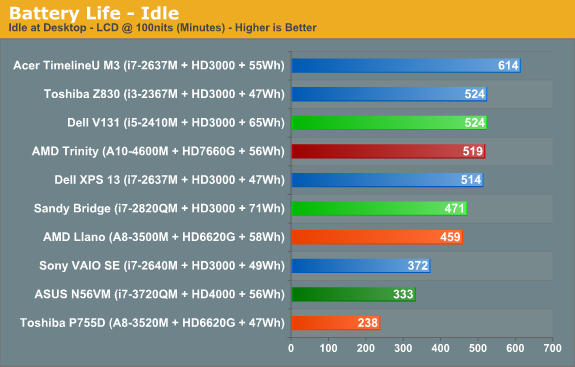
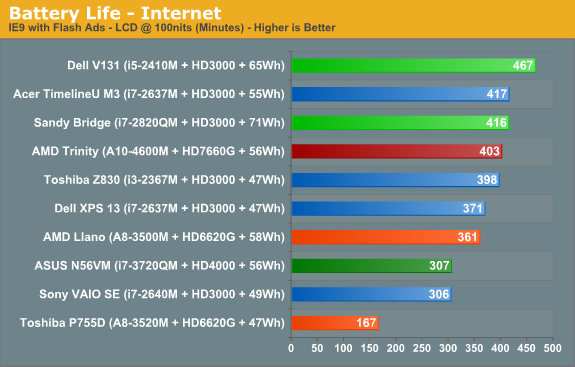
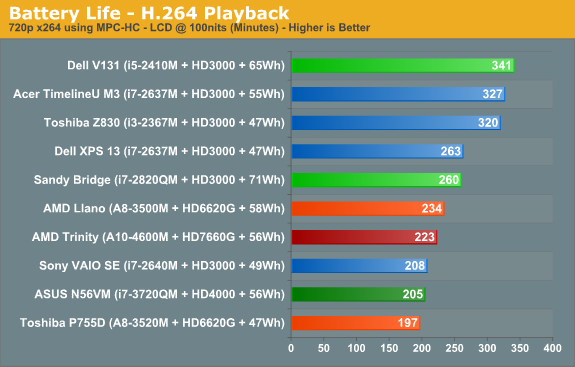
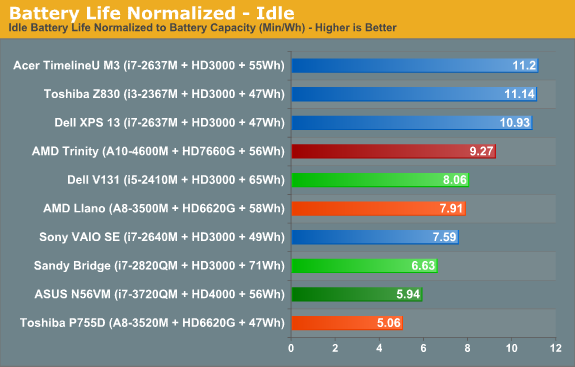

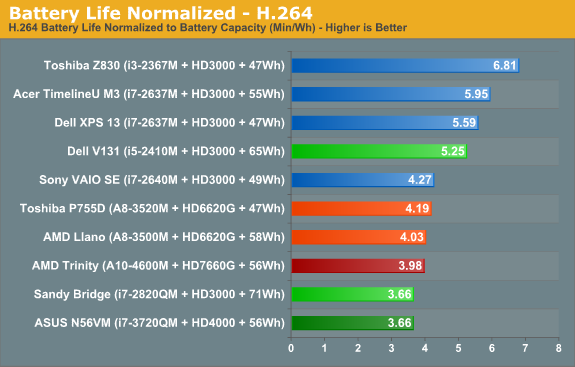
With a similar capacity battery to the original Llano laptop, and the same size 14” panel, Trinity comes out of the gates and posts two clear wins: idle battery life and Internet battery life are both up substantially relative to Llano. In fact, looking at the normalized charts, the only laptops that can consistently beat Trinity are found in Sandy Bridge ultrabooks—we won’t even bother discussing Atom or Brazos netbooks, as they’re competing in a completely different performance bracket. In something of a surprise, H.264 battery life doesn’t see the same benefit unfortunately, and it’s the one discipline where Llano still holds on to a slight lead over Trinity. Sandy Bridge meanwhile has always done very well in H.264 battery tests, and we see that with the Vostro V131 posting a normalized score that’s 30% better than Trinity and Llano. Of course, on the other end of the spectrum we have Ivy Bridge; we’ve only looked at one Ivy Bridge laptop so far, but if the pattern holds than Ivy Bridge will generally be a moderate step back in battery life relative to Sandy Bridge, giving AMD an even larger lead in this area.
We also performed a few other tests that we won’t present in graph form. One set of tests we alluded to earlier: the charts show Trinity with a Samsung 830 SSD, but we also ran tests with an Intel 520 SSD. Idle battery life dropped to 476 minutes (an 8% decrease), Internet battery life checked in at 371 minutes (down 8% again), and H.264 battery life stayed nearly the same at 217 minutes (down less than 3%). If battery life is one of your primary concerns, remember: all SSDs are not created equal!
Another test that we ran is simulated gaming; we looped the four graphics tests in 3DMark06 at 1366x768 until the battery ran out. We’ve run this same test on quite a few other laptops, and Llano initially looked to be far and away the best solution. Later, we discovered that when we tested Llano we were letting the GPU run in power saving mode—basically half the performance you’d get compared to being plugged in. We retested and measured 98 minutes, so the extra graphics performance comes with a heavy cost. We only tested Trinity (and Ivy Bridge and Sandy Bridge) using higher performance graphics settings, and this is one more area where it scores worse than Llano: Trinity managed just 77 minutes. That’s about the same as Ivy Bridge and Sandy Bridge (79 and 73 minutes, respectively), so if you’re after better gaming performance while running off the mains, you might need to keep looking.
Before getting too carried away with the above results, you still need to consider how important battery life is for your usage model. Some people travel a lot and like to go all day without plugging in; others will go from place to place and plug in whenever they’re not on the go. If you fall in the latter category, battery life isn’t usually a problem with any decent laptop, while those looking for all-day computing will definitely want as much mobility as possible. Ultimately, battery life is a factor of battery capacity as well as power optimizations done by the OEMs. We’ve seen battery life improve by as much as 50% when comparing two otherwise similar notebooks, but at least AMD’s reference platform for Trinity delivers a great starting point.
Temperatures and Acoustics
One other item we wanted to quickly touch on is system temperatures. We typically use HWMonitor and check temperatures of laptops under idle and load conditions. We did this with Trinity as well, but unfortunately the current version of HWMonitor doesn’t give us a lot of information. The only temperatures it reports are from the SSD and the HD 7660G graphics—there’s nothing about CPU core temperatures. That means we can’t provide much detail, other than to say that load temperature on the GPU topped out at 71C during extended testing, while the idle temperature was 39C. As usual, temperatures and noise levels go hand in hand, and the low 71C maximum GPU temperature matches up nicely with noise levels that never got above 37dB. It’s not the quietest laptop we’ve ever tested, and surface temperatures can get a little warm, but overall Trinity looks to be a good balance of performance and power requirements, which means quiet laptops are definitely possible.










271 Comments
View All Comments
Khato - Tuesday, May 15, 2012 - link
Really? The A10-4600m is going to be a $126 chip? 'Cause that's what a third of the tray price for an i7-3720QM is.BSMonitor - Tuesday, May 15, 2012 - link
You get 1/3 the performance on the CPU side.bji - Tuesday, May 15, 2012 - link
I don't know why I am bothing to respond to you, because your comments are all worthless, but I'd like to point out to anyone else who might be reading, that the CPU performance numbers are alot closer to 1/2 to 2/3 of the performance on the CPU side than 1/3.And 1/2 to 2/3 of Ivy Bridge CPU performance is *definitely* fast enough for 95% of users in 95% of circumstances, despite what trolls are claiming.
bji - Tuesday, May 15, 2012 - link
Sorry, forget I said 2/3. That was just one benchmark. Let's just leave it at 1/2.I think my point is still valid. 1/2 of Ivy Bridge performance at 1/3 cost is going to be very acceptable to the vast majority of people.
JarredWalton - Tuesday, May 15, 2012 - link
But the problem is you have to buy the whole laptop. If IVB goes for $350 and Trinity for $115, but the rest of the laptop ends up being $400, that means you get half the performance for 70% of the cost. And when Intel ships DC IVB chips for $150, we might be looking at 70% of the performance for 90% of the cost.My biggest fear with Trinity (if you couldn't tell from the conclusion) is that the laptop OEMs will price it too high. I think A10 is a decent part, provided you can get a reasonable set of laptop hardware for $600 or less. Anyway, we'll have to see what actually comes out and how much it costs.
bji - Tuesday, May 15, 2012 - link
Very good points. Then we have to throw in the question of how much the extra performance is worth to the user. We'd all take extra performance for free (assuming that it didn't come at a cost of heat or battery life or other features), but would you pay 10% more for more performance that you knew you didn't need? I don't think most consumers really think in these terms of course, marketing will sell these parts, not logic, but if we're trying to make price and value comparisons, we need to be aware that the goal is to get what you need for the least money, not more than you need for the least amount more money.JarredWalton - Tuesday, May 15, 2012 - link
I'd take Trinity with an SSD over Sandy Bridge with an HDD, provided I could get a good LCD and build quality thrown into the mix. Maybe HP will deliver with the upcoming Envy Sleekbooks?mrdude - Tuesday, May 15, 2012 - link
HP offered this with the Llano, granted they charge $150 for a 1080p screen... You can also opt to buy an aftermarket 1080p screen and DIY. The Asus Llano line was extremely popular because you can buy a $70 1080p matte finish screen and upgrade a crossfired Llano. For ~$600 you got great gaming performance and a 1080p screen. Those things sold like hotcakes too.Jarred, I think you neglected quite a bit in this review. The improvements we've seen in Llano > Trinity actually outweigh the improvements we've seen in SB > Ivy yet the latter also has the advantage of a die shrink. The perf-per-watt improvements are by far the biggest shocker here and are nothing short of unbelievable if you consider Bulldozer's power consumption.
While I understand using the 3720QM for the HD4000 benchmarks, why not delve into examining the Piledriver cores? There's very little info at all there with respect to what changed and what got better. What we got instead were synthetic benchmarks and a re-cap of the scores instead of some actual info. Hell, a monkey can run a benchmark but can that monkey run some meaningful benchmarks that test cache latency? AVX performance? Stress the IMC?Instead you're stating something that should be obvious (the weird multi-threaded cinebench score that actually makes sense when you consider it's a CMT design in Trinity therefore it lacks 2 FPUs compared to Llano) and that's supposed to be surprising?
I can understand wanting to get a review out in time and giving us a rough idea of performance, but this is Anandtech. We expect a bit more than "these are the scores and these are the numbers. Onto the next benchmark."
Spunjji - Wednesday, May 16, 2012 - link
I hear this.mikato - Wednesday, May 16, 2012 - link
I agree too (though the monkey part was a bit much). Maybe we can see a more in depth analysis of results, similar to Anandtech's treatment of AMD's new architecture but with hard results leading the analysis.